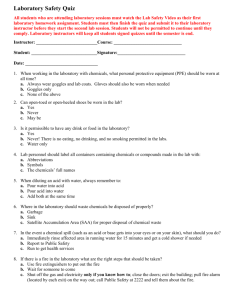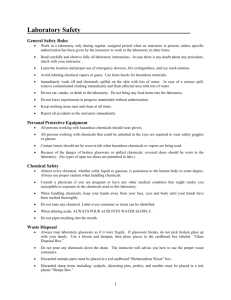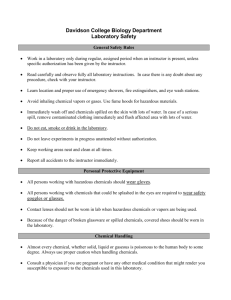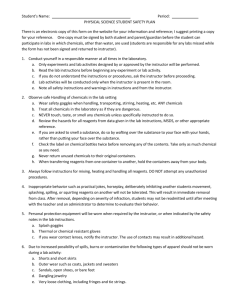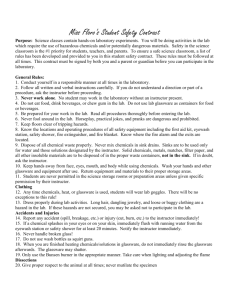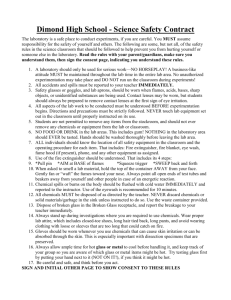Safety Rules 14-15 - Morris Hills Regional District First Class
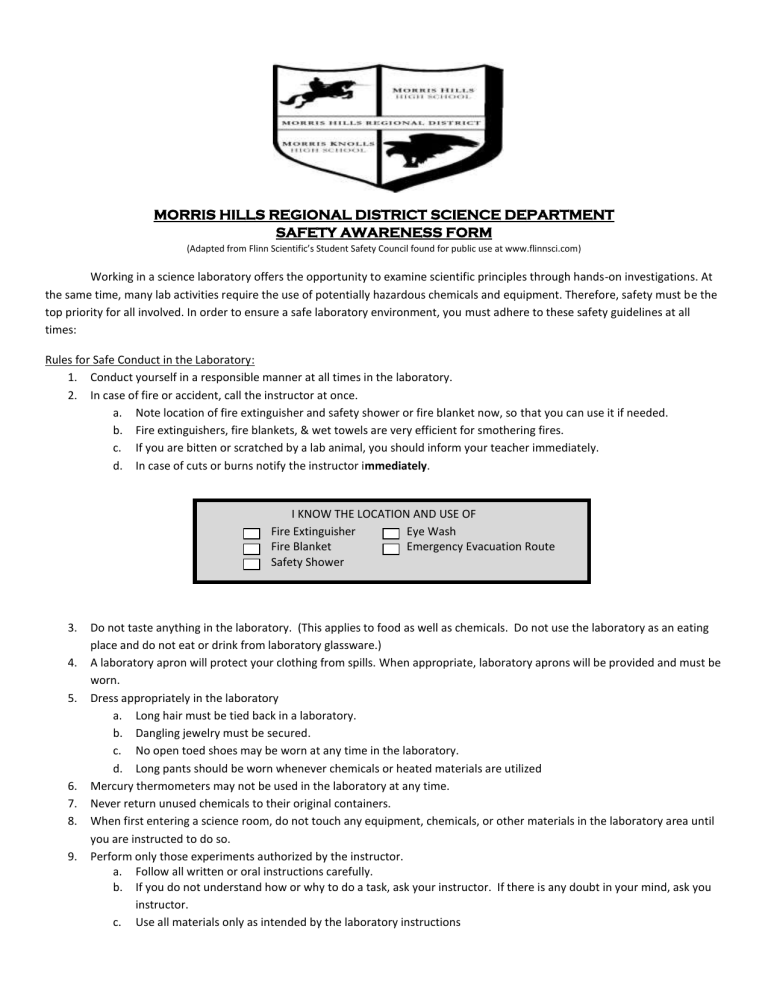
MORRIS HILLS REGIONAL DISTRICT SCIENCE DEPARTMENT
SAFETY AWARENESS FORM
(Adapted from Flinn Scientific’s Student Safety Council found for public use at www.flinnsci.com)
Working in a science laboratory offers the opportunity to examine scientific principles through hands-on investigations. At the same time, many lab activities require the use of potentially hazardous chemicals and equipment. Therefore, safety must be the top priority for all involved. In order to ensure a safe laboratory environment, you must adhere to these safety guidelines at all times:
Rules for Safe Conduct in the Laboratory:
1.
Conduct yourself in a responsible manner at all times in the laboratory.
2.
In case of fire or accident, call the instructor at once. a.
Note location of fire extinguisher and safety shower or fire blanket now, so that you can use it if needed. b.
Fire extinguishers, fire blankets, & wet towels are very efficient for smothering fires. c.
If you are bitten or scratched by a lab animal, you should inform your teacher immediately. d.
In case of cuts or burns notify the instructor immediately.
I KNOW THE LOCATION AND USE OF
Fire Extinguisher
Fire Blanket
Safety Shower
Eye Wash
Emergency Evacuation Route
3.
Do not taste anything in the laboratory. (This applies to food as well as chemicals. Do not use the laboratory as an eating place and do not eat or drink from laboratory glassware.)
4.
A laboratory apron will protect your clothing from spills. When appropriate, laboratory aprons will be provided and must be worn.
5.
Dress appropriately in the laboratory a.
Long hair must be tied back in a laboratory. b.
Dangling jewelry must be secured. c.
No open toed shoes may be worn at any time in the laboratory. d.
Long pants should be worn whenever chemicals or heated materials are utilized
6.
Mercury thermometers may not be used in the laboratory at any time.
7.
Never return unused chemicals to their original containers.
8.
When first entering a science room, do not touch any equipment, chemicals, or other materials in the laboratory area until you are instructed to do so.
9.
Perform only those experiments authorized by the instructor. a.
Follow all written or oral instructions carefully. b.
If you do not understand how or why to do a task, ask your instructor. If there is any doubt in your mind, ask you instructor. c.
Use all materials only as intended by the laboratory instructions
Rules Continued:
MORRIS HILLS REGIONAL DISTRICT SCIENCE DEPARTMENT
SAFETY AWARENESS FORM
10.
Students are never allowed into the storage or prep rooms at any time.
11.
Wear approved eye protection in the laboratory continuously. This means eye coverings, which will protect against impact and splashes. As per NJ State Law #18A:40-12.1 – PROTECTIVE EYE DEVICES REQUIRED FOR TEACHERS, PUPILS, AND
VISITORS IN CERTAIN CASES. By Board Policy, this includes laboratories in which caustic or explosive chemicals, hot liquids or solids, hot molten metals, projectiles, or explosives are used a.
Contact lenses should not be worn during lab experiments involving hazardous vapors, acids or bases. b.
If chemicals get into your eyes, immediately flush with running water from the eyewash station or safety shower for at least 20 minutes. Notify the instructor immediately. c.
If a chemical should splash on your skin, immediately flush with running water from the eyewash station or safety shower for at least 20 minutes. Notify the instructor immediately. d.
Any time chemicals, heat, projectiles, or glassware are used, students will wear laboratory goggles. There will be no exceptions to this rule! Goggles must be worn until everyone has completed the laboratory activities.
12.
When using sharp objects, including, but not limited to, scalpels and scissors, always cut in the direction away from your body.
13.
Never force glass tubing into a cork or stopper.
14.
Broken, chipped, or cracked glassware can never be used in the laboratory. a.
Check glassware for any chips or cracks. b.
Handle broken glassware carefully c.
Never handle broken glass with your bare hands. d.
Use a brush and dustpan to clean up broken glass. e.
Place broken or waste glassware in the designated glass disposal container.
15.
Test tubes should be pointed away from you and others when heating them.
16.
Read the label carefully before taking anything from a bottle or container. a.
Check the label on chemical bottles twice before removing any of the contents. Take only as much chemical as you need. b.
Using the wrong material could result in serious injury. c.
Do not pour reagents back into stock bottles or exchange stoppers. d.
All chemicals should be regarded as hazardous unless your instructor informs you otherwise. e.
Never mix or heat chemicals unless you are directed to do so. f.
When mixing concentrated acids and water, always pour acids into water slowly and stir constantly. g.
When observing the odor of any liquid, do not smell it directly. Use your hand to fan the odor towards you. h.
Dispose of all materials as instructor designates. i.
Never remove chemicals from the laboratory. j.
Do not use flammable chemicals near heat sources.
17.
Never look directly in the path of a laser or point it at others. Keep all reflective objects out of the beam’s path.
18.
Never look into a container that is being heated.
19.
Never leave a lit burner unattended. a.
Never leave anything that is being heated or is visibly reacting unattended. b.
Always turn the burner or hot plate off when not in use.
20.
Always work in a well-ventilated area. Use the fume hood when working with volatile substances or poisonous vapors.
Never place your head into the fume hood.
________________________
Print Student Name
________________________
Student Signature
________________________
Block
________________________
Teacher Signature
________________________
Parent Signature
____________________
Date
